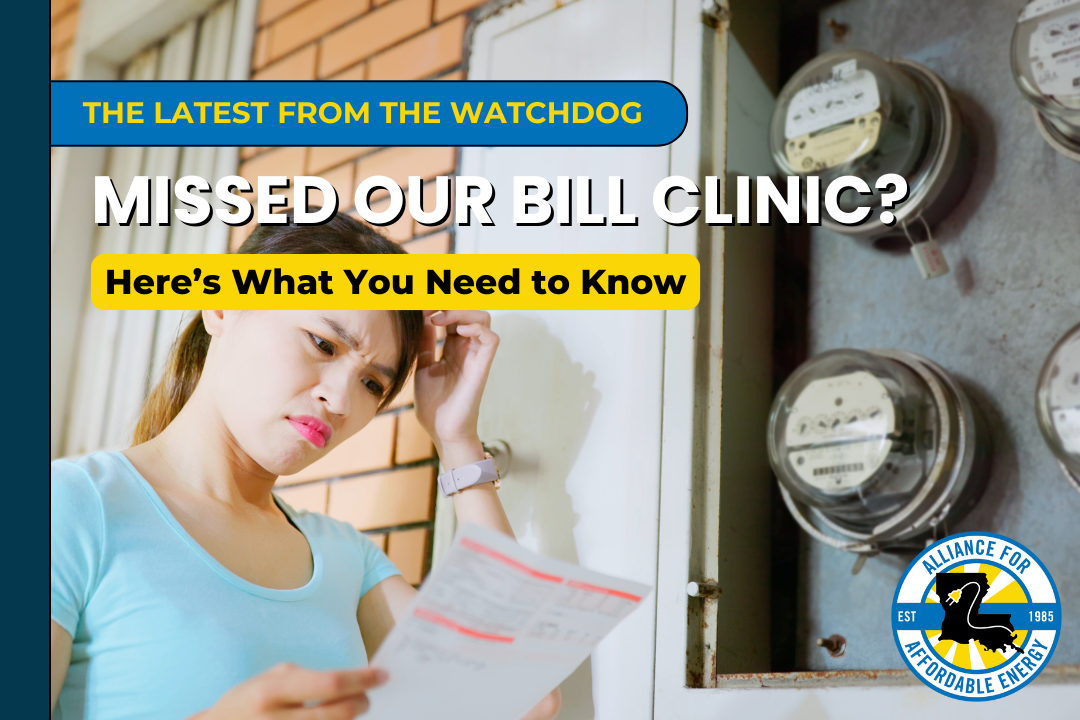🔎 First things first: What’s on your bill?
As customers, we pay for everything our utilities do. Your bill includes charges for:
- Infrastructure – power plants, poles, wires, substations
- Storm restoration costs
- Fuel costs – this is called “fuel charge” on your bill if you’re a Cleco customer. Fuel costs can include both the coal and gas needed to run a power plant and the power that utilities buy on customers behalf from the energy market.
- Operations and maintenance – Utility companies are in charge of maintaining our grid to ensure reliability, including managing trees and vines that may impact a pole or line, and ensuring the poles are sturdy enough. Operations include things like linemen, executives, customer service representatives, office space, and even ads.
- Taxes – local, state, and federal
- Profit – Utility companies make a near guaranteed profit on the bulk of their spending (this includes everything except for operations and maintenance). The amount of profit utilities can earn is set by the Louisiana Public Service Commission and is typically between 9-10%.
👉 Yesterday at the Bill Clinic we went over how these charges show up on your bill. For Cleco customers that means line items like TCJA Bill Credit, Storm Restoration and Energy Transition Charge, and Infrastructure & Incremental Costs Recovery. Want to learn more about these line items on your bill? Contact us!
💸 Now let’s talk about how utilities come up with your rates.
Think of your electric bill like a pie. Here’s how it works:
- The size of the pie = how much money the utility needs to bring in for the year to cover all expenses + their near guaranteed profit margin, of roughly 10%.
- The slices = how much power they expect customers in each class (residential, commercial, industrial) to use and how many customers they expect to serve.
The pie is paid for by all customers and costs are spread out over the full year. If the utility doesn’t earn enough in a given year, they are allowed to increase their rates to give them an opportunity the following year.
✅ The good news
If you’re a Cleco or SWEPCO customer you’re getting a REFUND. Last year, the Louisiana Public Service Commission (LPSC) approved refunds after your utilities overcharged you for power from the Dolet Hills coal plant.
- Cleco customers: Starting next month, you’ll get a credit for $11-12 per month on your July-September bills for the next 3 years. On your bill you’ll see this appear as “Dolet Hills Refund.”
- SWEPCO customers: You won’t see a direct refund, but the settlement will mean an overall reduction in electricity bill costs as the refund will go towards reducing costs associated with retiring and decommissioning the Dolet Hills coal mine.
This happened because of pressure from The Alliance and people like you! It’s a great reminder that we need to keep the spotlight on our regulators and our utility companies.
🚫 The bad news
Unfortunately, utilities like Cleco are still charging you too much. Instead of buying the lowest-cost energy available, they’re running older, more expensive coal plants like Rodemacher II and Big Cajun — and you’re paying for it. Over the past 10 years over $750 million has been wasted by running these two plants instead of using less expensive available power.
- Rochemacher II cost ratepayers $290,988,519
- Big Cajun II cost ratepayers $460,468,405
That’s money we could all be saving and the Louisiana Public Service Commission can put a stop to this wasteful practice.
💡 What you can do to lower your bill
We know power costs are adding up quickly, here are some tools that may help you manage your bill:
- Energy efficiency programs can help you lower your electricity bill and make your home more comfortable. By improving the energy efficiency of your home you’re using less energy to do the same job—whether it’s for cooling, keeping the lights on, or running appliances. These upgrades can help you save an average of $34 per month on your energy bills. Check out what savings programs are available to you by clicking here.
- Billing assistance programs, like LIHEAP, are available for low-income households. Find more information about options available to you in our blog here.
⚖️ What our regulators can do
The Louisiana Public Service Commission (LPSC) regulates most utilities in our state, including Cleco. Please note If you live in New Orleans, the City Council is responsible for regulating your utility, Entergy New Orleans. The LPSC makes decisions about what your energy costs, where it comes from, and what types of programs are available to you.
The LPSC can help bring bill costs down by:
- Investing in energy efficiency programs statewide
- Stopping uneconomic power plant operations by implementing a new rule
- Creating programs that can improve affordability, like a Percentage of Income Payment Plan that applies different, lower rates for low-income customers.
- Supporting community solar
- Prohibiting disconnections for vulnerable households
Commissioners need to hear from their constituents like you! Your emails and calls make a difference. Contact your regulators at the Louisiana Public Service Commission or New Orleans City Council today.
Contact Your Commissioner or Councilmember
